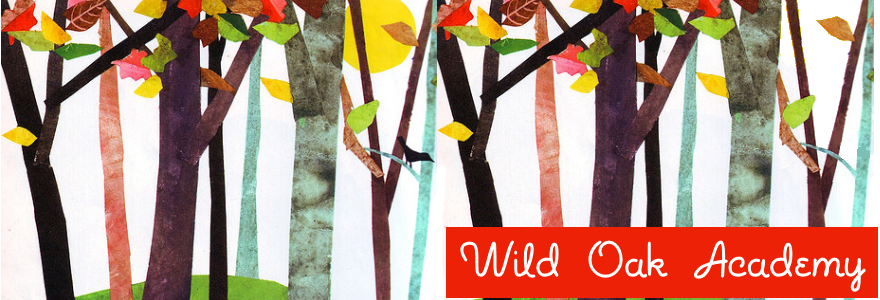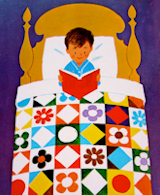This afternoon I spent a little time browsing for Autumn nature study ideas. I was thrilled to discover a Vintage Fall/Autumn Nature Study post at Happy Hearts At Home, then some fun creative writing projects: Letter Writing in Connection with Autumn Nature Study and finally this delightful "Fall Nature Study" (see below) from The Teacher, the School and the Community (1918) by Inez Nellie Canfield McFee. Altogether, there are some really wonderful ideas!
Fall Nature Study
What does it mean when the crickets chirp,
And away to the southland the wild geese steer;
When apples are falling and nuts are brown?
These are the signs that autumn is here.
[Our Little Ones]
Question the children for further signs of autumn. Have them bring in poems regarding Jack Frost. Talk about the preparations on every hand that Nature is making for winter. How does the wind sound in the fall? Read and discuss "The Gladness of Nature," by Bryant.
Poems:
- "Lost: The Summer," by R. M. Alden.
- "Fall Fashions," by Edith M. Thomas.
- "September," and "October's Bright Blue Weather," by Helen Hunt Jackson.
- "October," by Wordsworth.
- "Merry Autumn," by Paul Laurence Dunbar.
- "The Night Wind," by Eugene Field.
- What flowers bloom along the roadsides at this season?
- What flowers are blossoming in the garden?
- Make a collection of bulbs. Learn how to store them for the winter. What bulbs should be bedded at this season? Plant hyacinth, tulip, and narcissus bulbs in pots for forcing. They make lovely Christmas gifts.
- Tell the legend of the chrysanthemum; the legend of the goldenrod and aster; the legend of the closed gentian.
"Goldenrod," in Nature in Verse, by Mary Lovejoy. "Death of the Flowers," and "To the Fringed Gentian," by Bryant.
THE TREES
The splendor of the trees in autumn is ever a source of wonder and delight to the children. Encourage them to collect and press leaves for the decoration of the schoolroom. Group trees dressed in red and yellow, crimson, purple and green. Notice which trees change their leaves first. Explain why the trees are so gayly dressed. Once we thought the rich colors due to Jack Frost, now we know it is to the decaying mineral matter in the leaves. All summer long the leaves have busily sorted certain minerals from the air and water; the tree could not use them so the leaves obligingly stored them away in their own cells. How they are repaid for their labor in their beautiful dresses of every sheen and hue!
Read and discuss, "How the Leaves Came Down," by Susan Coolidge. Explain the real reason for the falling leaves: The sap of the tree absorbs the living matter and the food cells of the leaves as the cold weather draws near, so that the tree may store up enough nourishment on which to live through the winter, and to feed her tiny leaf buds until they get old enough to look after themselves. Have the children examine leaves that are ready to fall, and lead them to discover the layer of tissue which has been built across the end of the petiole; this loosens the leaf stalk and it only waits for a gale of wind to carry it away.
Remember next year's buds are formed before the old leaves fall. Autumn is really the beginning of the year as far as the tree's life is concerned. The children will delight in looking for the tiny babies. A willow branch will best serve for the first lesson, for its buds are the easiest to see. The bud is right at the base of the leaf stalk, enclosed in a single wrapping. It is made of two tiny leaves joined by their margins. Strip off the wrapper carefully with a needle and the bud is laid bare. But you cannot see how perfect it really is without a magnifying glass. There are five or six of next year's leaves, complete in every way, even to the veins and the delicate toothing of the edge. Some buds are very small and hard to find. If you were to pull off an old sumac leaf you would likely fail to see the bud. But wipe off the tiny drop of milk which fills the wound and you will find a small, pale hump. With a magnifying glass and a needle you can pick out the tiny cluster of next year's leaves. Perhaps the most interesting bud chamber of all is that of the honey locust. It is formed at the base of the old leaf stalk, and is a dear little room, shaped like a horse's hoof, all lined with a wall of white fur, and cuddling three or four baby leaf buds. The leaf buds of the sycamore are hidden in a chamber under the stem of the old leaf.
Pupils will be interested in studying the witch-hazel which, unlike other trees, blossoms in the fall.
Poems:
- "Autumn Woods," by Bryant.
- "Under the October Maples," by Lowell.
- "Before the Leaves Fall," by Margaret Sangster.
- "How the Leaves Came Down," by Susan Coolidge.
- "The Maple and the Pine," "October's Party," "Autumn
- Leaves," and "The Little Leaves" by George Cooper.
SEEDTIME
All summer long the plants and trees have been preparing for this the most important time of all the year. They have absorbed the sunshine and the rain, the light and the air, and the food which the hundreds of tiny rootlets have gathered from the soil in order to grow and perfect their seeds. And they have accomplished a noble work; for truly a seed is a most wonderful thing! Take, for example, the poppy seed. How very small it is! And yet a wondrous glory is folded inside.
Robes, my dear, that are fit for kings;
Scarlet splendor that dazzles the eyes;
Buds, flowers, leaves, stalks,— so many things!
[Celia Thaxter]
Many plants furnish seeds so rich in nourishment that they are good for food. (Ask the children to make a list of these.) It is not necessary for nature to take care in fashioning these seeds so that they may be easily distributed. Men will look after this business. This is also true of many of the seeds in the flower garden. We gladly gather them and tie them up in neatly-labeled packages ready for planting when spring comes. It is different with the wild flowers and weeds. If their species are renewed, it must be by their own efforts. Call attention to the dandelion and the thistle. Pull one of the airy silken balls to pieces and note the tiny seed at the end of each plume. How swiftly it sails with the wind! Lead the children to note other devices for seed distribution; have them group the plants according to the agent used. Thus:
Sails — dandelion, milkweed, cat-tail, thistle.
Hooks — burdocks, sticktights.
Wings — maple, linden.
Springs — touch-me-not, witch-hazel.
Often Mother Nature devises very cunning treasure boxes for the safe-keeping of her precious seeds. These boxes are not like any that we use. There are many different kinds. Such odd shapes and sizes and so wondrously colored! The children will enjoy making a collection of these. Make a list of plants that protect their seeds in burr, shell, and pod treasure boxes. Many seeds are concealed within treasure boxes that are themselves used for food, as the different kinds of fruit and vegetables. Take the watermelon for instance. The rich luscious fruit that we find so delicious is only a careful protection for the host of seeds in the very heart of the big treasure box. And the apple, the pear, and the orange-— to us these are the most Important things about the trees which bear them. But to the trees themselves it is the little seeds within these richly colored treasure boxes that are important.
How are seeds scattered? By the wind, by water, and by animals. Coconuts and certain beans and grains have been carried clear across the sea by the action of the waves, and have been planted upon new shores. Man scatters more seeds than all other agencies combined; he is continually buying, selling, and planting seeds. Hang pods, shells and burrs where children can watch them opening. Open a ripe milkweed pod; put the seeds in a bottle, so that the pupils may see how many seeds were packed in the tiny treasure box. Estimate the number of seeds growing on a single plant. Why are the seeds provided with sails? What would happen if they all settled down close about the mother plant? Lead the children to see that the struggle for life is less where the plants are different than in a clump where all are alike.
Make a school collection of garden, field, and weed seeds. For this purpose two-ounce bottles with screw tops are best. They may be labeled as useful seeds, pests, ways of distribution, and so on.
Bring in as many nut "samples" as possible, for a nut party.
Let all the work with seeds, fruit, and nuts typify the glory of the harvest home. (Read Dunbar's "Merry Autumn.")
Songs:
"October," and "Nutting Time."
Poems:
- "The Pumpkin," "The Fruit Gift," "The Huskers," by Whittier.
- "The Cornfields," by Mary Howitt.
- "Indian Summer," by Emily Dickinson.
- "The Cornstalk Fiddle," by Paul Laurence Dunbar.
- "When the Frost is on the Punkin," by J. Whitcomb Riley.
- "Maize for the Nation's Emblem," by Celia Thaxter.
- "A Thanksgiving," by Lucy Larcom.
Read Stedman's "Flight of the Birds." Talk about migration.
- Have pupils tell which birds are the first to go. Why do they leave?
- Do the birds that go south nest there?
- What birds stay all the year? Bring out the idea that birds living on worms and insects could find no food in winter. Those living on seeds sometimes remain in the North if the weather is not too severe.
- Hawks are more or less troublesome at this time of year. Talk about the common chicken hawk, the little blue darter, the sparrow hawk, and the sharp-shinned hawk. Are the hawks enemies of mankind? (See Birds That Hunt and Are Hunted, by Neltje Blanchan.)
- Learn to know some of the common water birds.
- Do the birds change their dress for winter? Bobolink and goldfinch are familiar types.
- "To a Waterfowl," by Bryant.
- "The Herons of Elm wood," by Longfellow.
- "The Departure of the Swallow," by W. Howitt.
- "The Wanderings of the Birds" and "The Last Robin," by H. S. Washburn.
- " Story of a Blackbird," by Alice Cary.
When we are getting ready for winter, what are all the wood animals doing? Do they know that winter is coming? How do the squirrels, the chipmunks, and the field mice prepare for winter? Who has discovered the fur- lined nest of a field mouse under some low, sheltered shrub, or dug into a squirrel's underground storehouse? Does the rabbit prepare for winter? Question children to bring out stories and habits of these little friends in fur. Read and discuss selections from Sharp Eyes by Gibson; read Queer Ways of Br'er Rabbit by W. Long. Mention enemies of the squirrels and rabbits, hawks, owls, weasels, foxes, hedgehogs, cats, and man. Read Riverby by Burroughs, and the fable of the Hare and the Tortoise.
How does the bear prepare for winter? He eats a great deal and gets very fat. Then he hunts about for a snug den in a hillside or for a sheltered hollow log or tree; here he sleeps until roused by the voices of spring. Ask the children to learn about other animals that spend the winter in sleep. Read Ways of Wood Folk, by William Long.
What about toads, frogs, and turtles? They burrow deep into the mud before the ground freezes. Bats hang themselves up by their toes in some cozy corner and sleep most of the time. The nuthatches, chickadees, and woodpeckers make many a winter meal from the countless insects and larvae sheltered under the bark of the trees. Flies creep into snug corners and cracks and lie as though dead, creeping out occasionally on warm, dry days. Spiders crawl into their dens and go fast asleep. Caterpillars build cradles for themselves on the sunny side of twigs and limbs, and under rocks and logs. How many have seen these odd cradles, or cocoons, as they are called? They are woven of fine silken thread, with now and then a bit of moss twined in for warmth and strength, and so fashioned that the caterpillar is securely shut up inside. Here he sheds his furry coat and dons a shiny, hard, brown one. The old coat is rolled up at his feet, and he goes to sleep snug and warm till spring calls. Who knows what happens then?
Talk about the habits of frogs and toads. Of what use are they? Frogs destroy large numbers of slugs and insects and serve in their turn as food for other animals. Toads destroy countless worms and larvae that are injurious to vegetation. They are valued allies in the garden and excellent flytraps!
What becomes of the bees and wasps in winter? Who in the summer has seen where a wasp has dug a tunnel in the packed sand, laid its eggs at the bottom, provisioned it with grasshoppers, and then filled it up so carefully that there was not a sign of the secret chamber?
How do the ants, beetles, and grasshoppers spend the winter?
References:
Bass, Florence. Highways and Byways and Stories of Insect Life.
Beard, J. C. Curious Homes and Their Tenants.
Burroughs, John. Birds and Bees.
Comstock, J. H. The Spider Book.
Ingersoll, Ernest. Wild Neighbors.
Kelly, M. A. B. Short Stories of Our Shy Neighbors.
Morley, M. W. Bee People.
Patri, Angelo. White Patch.
Labels: Autumn, Google Books, Nature Study
In preparation for the new school year, I decided to give our blog a much needed overhaul. The old layout simply wasn't working for me anymore, so I decided to brush up on my HTML/XML skills, experiment with digital scapbooking and tackle a new design. For the most part, I'm quite pleased with the results and hope that it will allow for easier updates throughout the year. The graphics used were from free digital scrapbooking sets found at Shabby Princess.
My number one pet peeve (and it's huge!) is that all of our rounded photos have a white background, which means they stand out rather unattractively now. I briefly debated removing and correcting all of the pictures, but that would have been a massive undertaking that I wasn't quite up for, so they remain. Eventually as new pictures are added, the old pictures won't be so prominent, but for now they bug me tremendously!
In the past few weeks I've been working hard to finalize our plans for the new school year, and changing my mind about a million times in the process. Shortly after my last post, I made the decision to scrap the bulk of my plans for history and use Tapestry of Grace instead. The TOG plans were surprisingly similar to my own, but helped fill in some of the gaps I'd been struggling with, so I think they'll be a good fit for us. I'm hoping that I've finally found a history program that we can stick with!
I am a bit concerned that so much history is covered in TOG Year 2, it moves quite a lot faster than I'd wanted. Nevertheless, I'm going to take it one unit at a time and see how things go, adjusting our pace as needed. We'll need to start out with Year 1, Unit 4 - in order to study Ancient Rome - before moving on to Year 2. And, I've got a few plans for history that I'm not willing to relinquish (such as a medieval garden project), so I'll be trying to work those in as we go along.
With our curricula for the year more or less established, I've been searching for ways to better organize myself. Organization is something that I've struggled with for years, and between working full-time and homeschooling this year, I realized that it's going to be important for my sanity to have a better system in place! My first step (aside from ordering Managers of Their Homes, which I still need to read), was inspired by Dawn at By Sun and Candlelight - I set up a file crate system. In my file crate thus far, I've got a folder for each month of the year, a planning calendar and weekly folders for each week of TOG Year 1, Unit 4. I'll be adding additional folders for the remaining weeks as I plan them. To spare myself a great deal of stress and confusion, I've decided to plan out one TOG unit at a time!
I haven't decided exactly how the system will work yet, but currently each folder contains the TOG weekly overview, along with the reading list and printables (worksheets, notebooking pages, additional reading, etc.) for the week. I've supplemented with printables from other sources, in addition to those provided by TOG. I'll be adding project ideas as I find them and have an index to the weeks typed up in Word. I'm thinking I'll pull and copy the printables as I do my planning each week so that the kids can add them to their binders as we go. This seemed a better option than handing them a pre-filled binder at the beginning of the year.
The monthly folders contain seasonal and liturgical ideas for the month - crafts, recipes, reading lists, etc. I'm hoping that this will enable me to incorporate these activities on a regular basis because it's something we all enjoy very much.
Labels: Organization, Planning
Dragon Bread - a recipe and a verse - also from Our Little Nature Nest.
Coloring Pages: St. Michael, St. Raphael, St. Gabriel
From Catholic Culture:
"Make some recipes related to Michaelmas. Of special mention is the St. Michael Bannock from Scotland, roast goose and stuffing from Britain, waffles from France, and roast duck from Germany or France, gnocchi from Italy. Blackberries, apples and carrots also play a large role on this feast in various countries. Other ideas: make an angel food cake, devil's food cake or angel hair pasta. Decorate with white, symbolizing the angels, or use other symbolic colors (see above). Non-dessert items: deviled eggs, deviled meats, etc."
"Try to find the Michaelmas daisy, a purple aster, to use for decoration. It also comes in other colors, including white, but purple is the most popular. It usually blooms in late summer until October. The official name is Aster novi-belgii, but is also known as New York aster."
"Folklore in the British Isles suggests that Michaelmas day is the last day that blackberries can be picked. It is said that when St. Michael expelled Lucifer, the devil, from heaven, he fell from the skies and landed in a prickly blackberry bush. Satan cursed the fruit, scorched them with his fiery breath, and stamped and spat on them, so that they would be unfit for eating. A Traditional Irish proverb says: On Michaelmas Day the devil puts his foot on the blackberries. If you have access to blackberries, make this the last picking and eating. Perhaps make a blackberry pie?"
Additional Ideas:
The Feast of the Archangels from Domestic-Church.com
Exploring Angels from Domestic-Church.com
The Angels from Around the Year with the Von Trapp Family
Labels: Autumn, Liturgical Year
Well here it is July, when I'd hoped to start our new school year, and we're not quite ready yet. It's been another rough month, but after some delays I finally had surgery a couple of weeks ago and following a rather nightmarish "adjustment" period, I seem to be on the road to recovery - hopefully my shunt won't pose any further problems (fingers seriously crossed!)!
Fortunately, despite everything, I've been steadily piecing together a plan for next year and doing a lot of reading. Since I'm passionate about the Middle Ages, I've been avidly researching all sorts of things and the results have been exhilarating - as far as history goes, it's going to be a wonderful year (or at least I hope so!)! I've decided to break from the traditional four-year cycle just a bit by devoting an entire year to the Middle Ages (AD 500-1400), There's simply too much to cover otherwise - especially when you consider that we've still got to get through Ancient Rome!
For everything else, here's my list in progress:
Language Arts
- English: Rod & Staff Building Christian English, continued from last year.
- Reading: Undecided. We have CLE Light Units from last year to finish, but I'm thinking that we may switch to the Faith & Freedom Readers from Seton, and/or their Reading Comprehension and Thinking Skills workbooks. I'm still working on our literature selections for the year.
- Penmanship: At a recent homeschool convention, my daughter selected Rod & Staff's Penmanship for Christian Writing for herself, however I've yet to find anything for the boys. I'm thinking they will most likely use CHC's Handwriting Level 4 and a little of Writing Can Help 5B: Scripture Handwriting. The latter includes instructions for a simple Versal script and designs like those used by monks to adorn scripture, which will be perfect as we study illuminated manuscripts.
- Vocabulary: English From the Roots Up - This was an impulse convention purchase, but I haven't yet decided if we'll actually use it.
- Spelling: Finally I've found a simple spelling/dictation program that I think I'll love: Spelling Wisdom.
Math
For Math, we'll finish up our Singapore books from last year, then progress to the next level(s).
Science
- Classical Astronomy: Signs & Seasons
- Botany: Jeannie Fulbright's Exploring Creation with Botany
- Art Appreciation: Seton's Art Through Faith, CHC's Learning to Appreciate Art and Art Masterpieces: A Liturgical Collection, plus several Sister Wendy art appreciation books.
- Home Economics: CHC's Sewing with Saint Anne, See and Sew: A Sewing Book for Children...more TBA.
- Japanese: Japanese has been requested by 3 of the kids (and I wouldn't mind learning myself!), but I'm still undecided. If we do pursue it, we'll use Genki with Japanese the Manga Way: An Illustrated Guide to Grammar and Structure, Kana de Manga: A Fun, Easy Way to Learn the ABC's of Japanese, Japanese in Mangaland and/or Kanji in Mangaland as supplements.
- Computer Programming: TBA






















